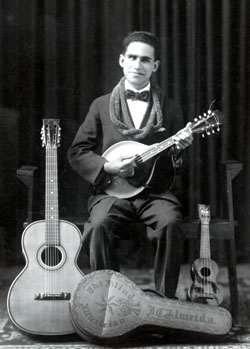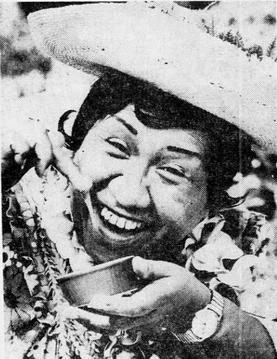
Hawaii is the largest island in the United States, located in the eponymous state of Hawaii. It is the southeasternmost of the Hawaiian Islands, a chain of volcanic islands in the North Pacific Ocean. With an area of 4,028 square miles (10,430 km2), it has 63% of the Hawaiian archipelago's combined landmass. However, it has only 13% of the archipelago's population. The island of Hawaiʻi is the third largest island in Polynesia, behind the north and south islands of New Zealand.

Hilo is the largest settlement in Hawaii County, Hawaii, United States, which encompasses the Island of Hawaii, and is a census-designated place (CDP). The population was 44,186 according to the 2020 census. It is the fourth-largest settlement in the state of Hawaii, the largest settlement in the state outside of Oahu, and the largest settlement in the state outside of the Greater Honolulu Area.

Mauna Loa is one of five volcanoes that form the Island of Hawaii in the U.S. state of Hawaii in the Pacific Ocean. Mauna Loa is Earth's largest active volcano by both mass and volume. It was historically considered to be the largest volcano on Earth until Tamu Massif was discovered to be larger. Mauna Loa is a shield volcano with relatively gentle slopes, and a volume estimated at 18,000 cubic miles (75,000 km3), although its peak is about 125 feet (38 m) lower than that of its neighbor, Mauna Kea. Lava eruptions from Mauna Loa are silica-poor and very fluid, and tend to be non-explosive.

Hula is a Hawaiian dance form expressing chant (oli) or song (mele). It was developed in the Hawaiian Islands by the Native Hawaiians who settled there. The hula dramatizes or portrays the words of the oli or mele in a visual dance form.

The Merrie Monarch Festival is a week-long cultural festival that takes place annually in Hilo, Hawaii during the week after Easter. It honors King David Kalākaua, who was called the "Merrie Monarch" for his patronage of the arts and is credited with restoring many Hawaiian cultural traditions during his reign, including hula. Many hālau hula (schools), including some from the U.S. mainland and some international performers, attend the festival each year to participate in exhibitions and competitions. The festival has received worldwide attention and is considered the most prestigious of all hula contests.
The following is an alphabetical list of articles related to the U.S. state of Hawaii:

Mark Kealiʻi Hoʻomalu is a contemporary Hawaiian chanter, who was born and raised in ʻAiea, Oʻahu. He is best known for his contributions to the soundtrack of the 2002 Disney animated film, Lilo & Stitch, providing the film's two non-Elvis Presley-related songs. His style is both innovative and controversial, as purists disapprove of the liberties he takes in creating new arrangements of ancient chants.

Banyan Drive is a tree-lined street at the shoreline of Hilo, Hawaii. It is known as the "Hilo Walk of Fame" for the banyan trees planted by celebrities. These trees have withstood several tsunamis that have devastated the town on the Big Island of Hawaii.
A hālau hula is a school or hall in which the Hawaiian dance form called hula is taught. The term comes from hālau, literally, "long house, as for canoes or hula instruction"; "meeting house", and hula, a Polynesian dance form of the Hawaiian Islands. Today, a hālau hula is commonly known as a school or formal institution for hula where the primary responsibility of the people within the hālau is to perpetuate the cultural practice of hula.

ʻIolani Luahine, born Harriet Lanihau Makekau, was a native Hawaiian kumu hula, dancer, chanter and teacher, who was considered the high priestess of the ancient hula. The New York Times wrote that she was "regarded as Hawaii's last great exponent of the sacred hula ceremony," and the Honolulu Advertiser wrote: "In her ancient dances, she was the poet of the Hawaiian people." The ʻIolani Luahine Hula Festival was established in her memory, and awards a scholarship award each year to encourage a student to continue the study of hula.

Hilo Bay is a large bay located on the eastern coast of the island of Hawaiʻi.
Rae Fonseca was an American hula dancer and hula master. Fonseca established the Halau Hula O Kahikilaulani in 1980, a Hilo-based halau.

John Kameaaloha Almeida was a blind musician and songwriter from Oahu, Hawaii.
Fabianne Pomaialoha Wong Dalire, known professionally as Aloha Dalire, was an American Hawaiian kumu hula, or master hula teacher. She won the first Miss Aloha Hula as Aloha Wong, in 1971, the same year that the Merrie Monarch Festival was established. The Miss Aloha Hula title is hula's top solo wahine (women's) honor.

Myrtle Keahiʻaihonua Kalanikahea Hilo was a native Hawaiian taxicab driver, radio personality, ʻukulele player and singer. Her signature album The Singing Cab Driver was released in 1967 on Makaha Records. She was born in Hauʻula, Hawaii on the island of O'ahu. In 1998 she received the Lifetime Achievement Award from the Hawai'i Academy of Recording Arts.
Carlson Kamaka Kūkona, III, otherwise simply known as Kamaka Kūkona, is an American musician, vocalist, songwriter, record producer, kumu hula, and educator.

The Hilo Hawaiian Hotel located in Hilo, Hawaii's second largest town, is one of a few relatively large hotels on the east coast of Hawaii Island. It is located, like the Grand Naniloa Hotel, on Banyan Drive.

Edith Kenao Kanakaʻole was a Hawaiian dancer, chanter, teacher, and kumu hula. Born in Honomū, Hawaiʻi in 1913, she was taught hula from a young age, and dropped out of her formal schooling before completing middle school. She began to compose traditional Hawaiian music in 1946, choreographing hula to accompany many of her chants, and founded Hālau O Kekuhi in 1953. In the 1970s, she taught Hawaiian studies and language at Hawaiʻi Community College and later the University of Hawaiʻi at Hilo, where she worked until her death in 1979.

Hawaiian Host Group (HHG) is a Hawai‘i-based consumer goods and agricultural manufacturing company. It is the largest branded macadamia nut company in the world, with a portfolio of brands that includes Hawaiian Host, Mauna Loa, MacFarms, KOHO, and Kapua Orchards. Sold in over 23 countries, HHG produces a suite of products ranging from flavored macadamia nuts to artisan chocolates, and macadamia milk-based ice cream. Its 500 employees are spread across the HHG headquarters in Honolulu and offices in Hilo, Kona, Los Angeles, and Tokyo. HHG has manufacturing plants in Honolulu and Kea‘au, as well as Hawai‘i’s single largest macadamia farm, south of Kona.

Kenneth Hon, usually known professionally as Ken Hon, is a geologist and the 21st Scientist-in-Charge (SIC) of the Hawaiian Volcano Observatory (HVO), serving since 2021; succeeding Tina Neal (SIC) and David Phillips. Hon has often been a contact from the Observatory to the news media, and as such is often quoted as an authority figure in the field of Hawaiian volcanology.



















